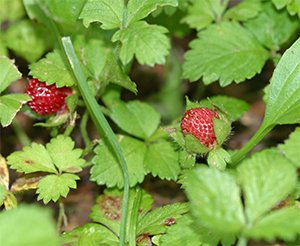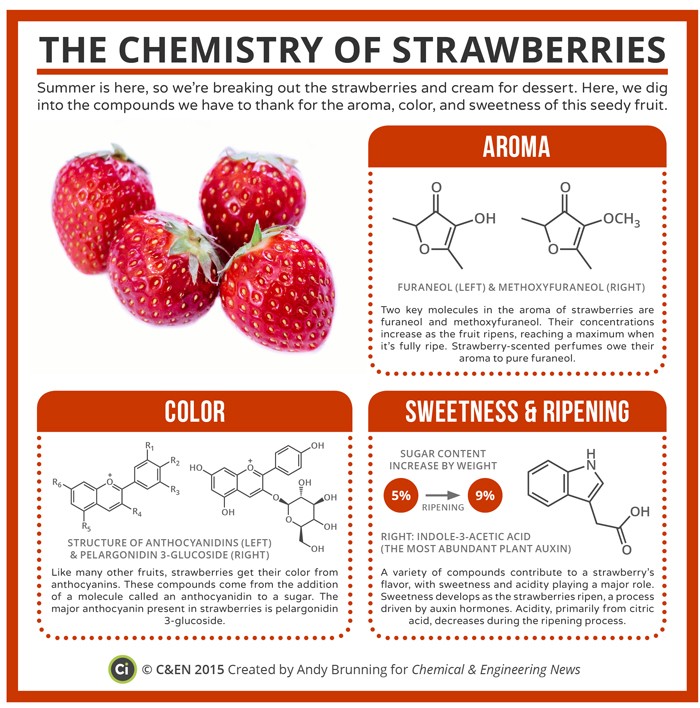
Wild strawberries are much smaller than their store-bought cousins, but 20 times as flavourful.
Did you know that the strawberry is a member of the rose family? This relationship explains why the strawberry smells so divinely sweet and intoxicating. Because of it’s heart shape and red colour, the strawberry features in many pieces of literature to stand for love and passion, but also for purity and righteousness because of it’s sweetness. For example medieval stone masons carved strawberry designs on altars and around the tops of pillars in churches and cathedrals for righteousness and purity .
Strawberries, besides being delicious fruit, are extremely valuable for medicinal uses. The flavonoid, anthocyanins, are found in the berries, which have been shown to reduce the rate of heart attack by 32% in young women . Another flavonoid in strawberries, quercetin, is known to reduce inflammation. But quercetin, and our beloved berry, doesn’t stop there: it may also have the ability to lesson the chances of cancer, but more tests are needed to truly prove that idea .
Strawberries are known for a high vitamin C content, but they also have a high potassium which makes them one of the top recommended foods for folks with high blood pressure and other low potassium disorders .
On the less extreme side, strawberries can help with cases of constipation (because of their water content), depression (due to the folate), and an overall stronger immune system (due to the vitamin C).
How do you make the most of this besides eating the berries in as many dishes as possible? You can make a tea out of the leaves, root parts, or dried berries. Some many even recommend crushing up the berries and applying it to a sunburn to ease it ; however, if you find eating the berries more satisfying it, you may want to leave the sunburn to your aloe plants.
Then, there are Junebearers which produce medium to very large berries , but are only seasonal growth. There are many more speicies of these, and two of the most popular I have seen around the midwest of the United States are Jewel and the Earligrow.
Finally, there are everbearers, which produce smaller berries more frequently throughout the year. I successfully grew these in a pot for 5 years while in university. What I like about them is that they produce fruit from spring to summer, even if they are smaller fruits. Bruce Bordelon at Purdue’s Extention Office says that Ozark Beauty, Fort Laramie, Quinault are pretty good potentials from this category. I had the Fort Laramie, so I can confidently say that species is a pretty good bet.
Soil: Strawberries do the best in well drained, sandy loam or loam soils. That being said, they can also grow in any soil that drains well between waterings. Strawberries also prefer slightly acidic to neutral soils at a pH of 5.5 to 7.
Sun: Most strawberry plants prefer full sun. The one exception is a day-neutral plant grown in a climate that is too warm for it, as discussed above.
Spacing: Strawberries sent out runners that can take a great deal of room. If you are planting rows, make sure they have 4 feet between rows, and anywhere between 12 to 36 inches apart for the plants. If you are planting a single plant, make sure there is plenty of room for the runners to travel or fall.
For a more abundant growth, pinch off the flowers the first year. This will promote stronger root growth and more vigorous runners . The next year the fruit will be better quality when harvested.
As food:
- Classic fruit salad
- Strawberry shortcake
- Garnishments
- Oatmeal
If you have a lot of berries and you just can’t stomach them any more, slice them up and dry them out. Then, you can put dried strawberries in your cereals and oatmeal or in your tea.
Speaking of tea, one of the most delightful tea recipes I’ve ever tried is that of my great-grandma’s. Here it is from the moment of harvest at the end of the season.
Dry the leaves, stems, and hips of the strawberries. Once dried, lightly crush and store in an air-tight container away from direct sunlight until ready to use.
When ready to make tea, bring the water to a boil and transfer to a cup. (Remember, we British people use 6oz tea cups!)
Shake the container to mix the leaves, stems, and hips, then add 1 – 2 teaspoons of the mix to a teaball. Add in pieces of dried fruit if you wish, or honey if you have a sore throat. Let steep for 5 minutes, then remove the teaball.
I found that I could often use the teaball twice if I steeped it for 3 minutes, which is my personal preference. However, Great-grandma was adamant that you should steep it for 5 minutes to extract all the flavour and nutrients, then throw it away. The choice, though, is purely based on taste, and I tend to like a less astringent tea.
Instead of throwing a full list of chemicals at you, here is a great view of the simplified version of strawberries. Thank you, Andy Brunning!

Strawberry chemistry simplified. Image and graphic by Andy Brunning and Chemistry and Engineering News.
